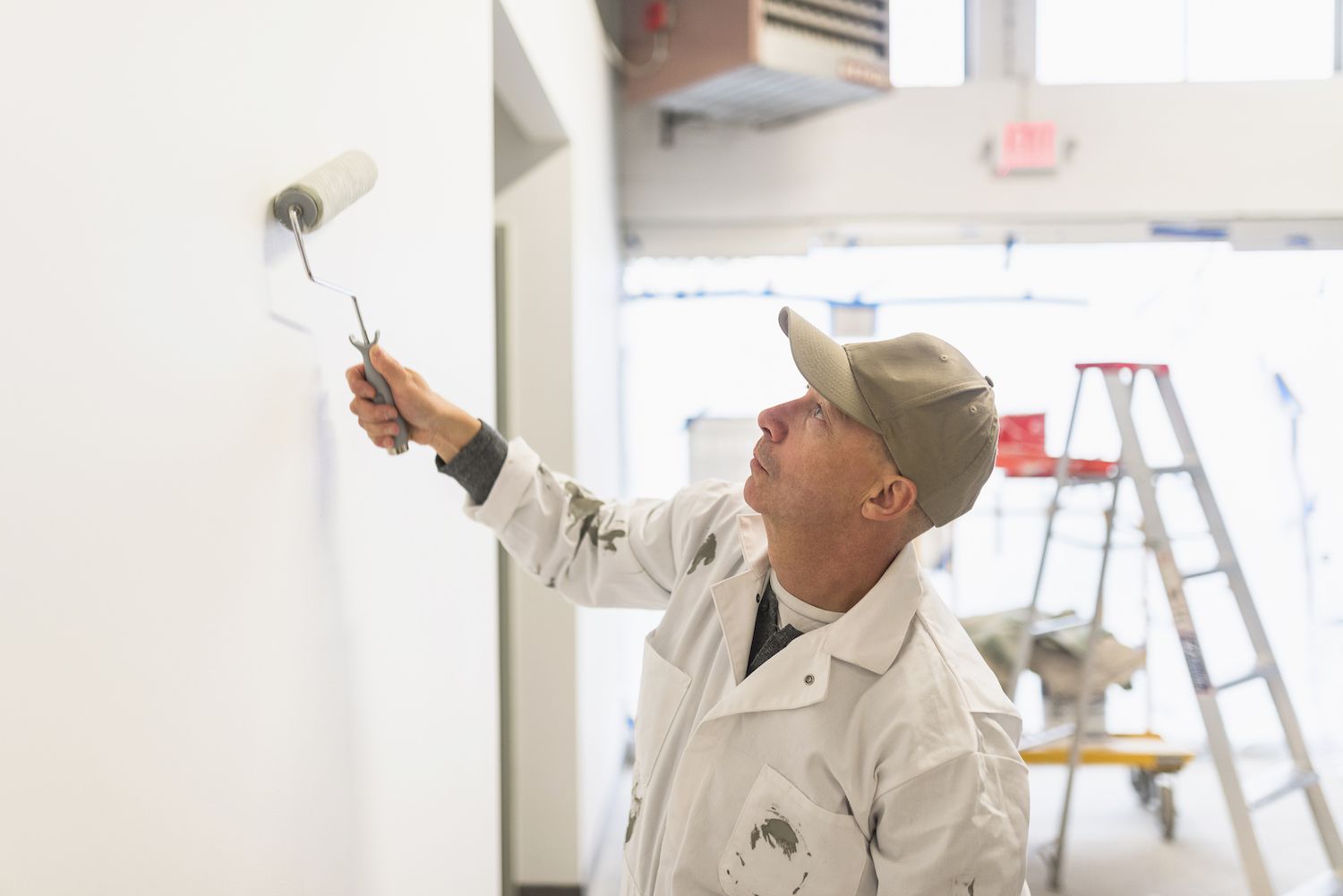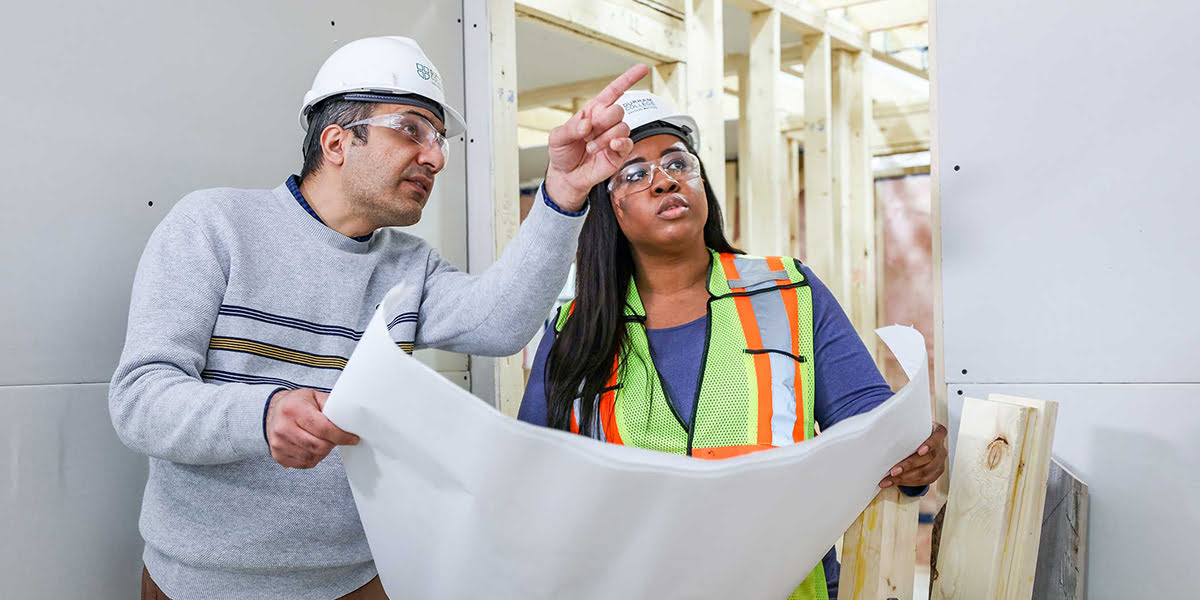Home>diy>Building & Construction>What Education Do Construction Painters Have


Building & Construction
What Education Do Construction Painters Have
Modified: January 5, 2024
Learn what education is required for construction painters in the building-construction industry. Find out the qualifications and training needed to excel in this field.
(Many of the links in this article redirect to a specific reviewed product. Your purchase of these products through affiliate links helps to generate commission for Storables.com, at no extra cost. Learn more)
Introduction
Construction painters play a vital role in enhancing the aesthetic appeal and protection of buildings. They are skilled professionals who apply paint and coatings to various surfaces, transforming them into visually appealing spaces. Whether it’s a residential home, commercial building, or industrial facility, construction painters bring life and color to these structures.
However, becoming a construction painter requires more than just a passion for painting. It requires a certain level of education and training to master the necessary skills. In this article, we will explore the educational pathways available for individuals aspiring to become construction painters.
While formal education is not always mandatory, it can greatly benefit those who pursue it. It provides a strong foundation of knowledge and techniques that will be invaluable throughout a painter’s career. Let’s dive into the different educational avenues available for construction painters.
Key Takeaways:
- Education and training are essential for aspiring construction painters, with options including high school art classes, apprenticeship programs, trade schools, on-the-job training, and continuing education to stay updated on industry advancements.
- Formal education, hands-on experience, and industry certifications are crucial for construction painters to excel in their careers, providing the skills, knowledge, and expertise needed to succeed in this dynamic field.
Read more: What Is A Construction Painter
High School Diploma or Equivalent
Obtaining a high school diploma or its equivalent, such as a GED, is the first step towards pursuing a career in construction painting. While not directly related to painting, a high school diploma signifies a basic level of education and is often a requirement for further training and apprenticeship programs.
During high school, individuals can take advantage of art classes to develop their creativity and understanding of color theory. These classes provide a solid foundation for aspiring painters and allow them to explore different techniques and mediums.
In addition to art classes, it is also beneficial to take courses in math, English, and physics. Strong mathematical skills are essential for measuring and calculating paint quantities, while English skills are necessary for understanding safety guidelines, product labels, and instructions. Physics knowledge comes in handy when dealing with surface preparation, understanding paint adhesion, and applying coatings correctly.
While a high school diploma is the minimum requirement, it is always beneficial to excel academically. Building a strong academic foundation can open doors to opportunities for further education or advanced training in the field of construction painting.
Individuals who did not complete high school can obtain a General Education Development (GED) certificate. The GED test covers topics typically learned in high school and certifies that an individual has the necessary knowledge and skills equivalent to a high school graduate. Holding a GED certificate can provide the same opportunities as a high school diploma and serve as a starting point for a career in construction painting.
Overall, a high school diploma or equivalent is the first requirement to embark on the path to becoming a construction painter. It demonstrates basic educational competency and provides a foundation for further training and skill development.
Apprenticeship Programs
Apprenticeship programs provide aspiring construction painters with a comprehensive and hands-on learning experience. These programs combine on-the-job training with classroom instruction, allowing individuals to gain practical skills while also acquiring theoretical knowledge.
Apprenticeships typically last 2 to 4 years, depending on the program and region. During this time, apprentices work under the guidance of experienced painters who mentor and train them in various aspects of the trade. They learn how to prepare surfaces, select and mix paints, apply coatings using different techniques, and follow safety protocols.
In addition to the practical training, apprenticeship programs also include classroom instruction. Apprentices attend classes where they learn about paint properties, surface preparation techniques, color theory, safety regulations, and industry best practices. These sessions provide a deeper understanding of the materials and processes involved in construction painting.
One significant advantage of apprenticeship programs is that apprentices receive a wage while they learn. This allows them to earn an income while gaining valuable hands-on experience. As they progress through the program, their wages may increase to reflect their growing skill level.
Apprenticeships are typically offered through trade associations, unions, or government-sponsored programs. These organizations collaborate with construction companies and contractors to provide structured training programs for aspiring painters. To enter an apprenticeship program, individuals usually need to meet specific eligibility requirements, such as age restrictions, educational qualifications, and physical fitness.
Completing an apprenticeship program not only equips individuals with the necessary skills to become proficient painters but also enhances their employability. Employers often value apprenticeship training as it demonstrates a commitment to the trade and a willingness to learn and improve.
Furthermore, successful completion of an apprenticeship program can lead to industry-recognized certifications or journeyman status. These credentials validate an individual’s expertise and can open doors to higher-paying job opportunities or the possibility of starting a painting business of their own.
In summary, apprenticeship programs provide a structured and comprehensive learning experience for individuals aspiring to become construction painters. They combine practical training with classroom instruction, allowing apprentices to develop essential skills while earning a wage. Completion of an apprenticeship program can lead to industry certifications and improved career prospects.
Trade Schools or Vocational Training
Trade schools and vocational training programs offer an alternative educational pathway for individuals looking to specialize in construction painting. These programs provide focused and intensive training that equips students with the skills and knowledge needed to excel in the field.
Trade schools typically offer programs specifically designed for construction trades, including painting. Students enrolled in these programs receive classroom instruction as well as hands-on training in state-of-the-art facilities that simulate real-world painting scenarios.
Trade school curricula often cover a wide range of topics, including surface preparation, paint application techniques, color mixing, safety procedures, and customer service. Students learn about different types of coatings, tools and equipment, and industry best practices.
One of the advantages of trade schools is the expertise of the instructors. Many trade school instructors have extensive experience as professional painters, which allows them to provide practical insights and mentorship to the students. Students also have the opportunity to network with industry professionals, which can open doors to job opportunities after graduation.
Vocational training programs, on the other hand, are typically offered at community colleges or adult education centers. These programs focus on providing specialized training in specific trades, including construction painting. They are often shorter in duration compared to trade school programs and may offer flexible scheduling options to accommodate working professionals.
Similar to trade schools, vocational training programs provide a combination of classroom instruction and hands-on practice. Students learn the fundamentals of painting techniques, surface preparation, safety protocols, and industry standards. These programs are designed to equip students with the necessary skills to enter the workforce quickly and confidently.
Trade schools and vocational training programs are a great option for individuals who prefer a more concentrated and focused approach to learning construction painting. These programs offer specialized training, industry connections, and the opportunity to develop hands-on skills in a supportive and immersive learning environment.
Upon completion of a trade school or vocational training program, graduates receive a certificate or diploma that validates their skills and knowledge in construction painting. This credential can enhance their employability and serve as evidence of their dedication to the craft.
Overall, trade schools and vocational training programs provide a structured and intensive educational pathway for individuals looking to specialize in construction painting. These programs offer focused instruction, hands-on training, and industry connections, empowering graduates to succeed in their careers.
Many construction painters have a high school diploma or equivalent. Some may also complete a formal apprenticeship program or vocational training in painting and coating application.
On-the-Job Training
On-the-job training (OJT) is another valuable avenue for individuals seeking to become construction painters. OJT provides practical experience and hands-on learning directly in the field, allowing individuals to develop their skills while working alongside experienced professionals.
Many construction companies and painting contractors offer on-the-job training programs for entry-level painters. These programs typically involve starting as a helper or apprentice and gradually taking on more responsibilities as skills and knowledge are gained.
During on-the-job training, individuals work under the guidance and supervision of experienced painters. They learn valuable techniques such as surface preparation, paint application, using various tools and equipment, and following safety protocols. The instruction received during OJT is highly tailored to the specific needs and requirements of the company or contractor.
The benefit of on-the-job training is that individuals can immediately apply what they learn in a real-world setting. They have the opportunity to work on different types of projects, learn firsthand about the challenges and intricacies of the trade, and develop valuable problem-solving skills.
On-the-job training also provides the advantage of networking and building professional relationships within the industry. Working alongside experienced painters exposes individuals to a wide range of techniques, tips, and industry practices that cannot always be learned in a classroom or training program.
While on-the-job training does not typically result in formal certifications or diplomas, it does provide invaluable hands-on experience that can be highly regarded by potential employers. Many painting companies value practical experience and view it as evidence of an individual’s ability to perform well in a professional setting.
It is important to note that on-the-job training may have varying durations, depending on the company or contractor. Some individuals may spend several months working as a helper or apprentice, while others may need several years to develop the necessary skills and knowledge to work independently.
Overall, on-the-job training offers a practical and immersive approach to learning construction painting. It provides individuals with the opportunity to acquire skills, knowledge, and firsthand experience in a real-world setting, contributing to their professional growth and career development.
Read more: What Education Is Required For Construction
Continuing Education and Certifications
Continuing education and certifications are essential components of a construction painter’s career development. These opportunities allow painters to stay updated on the latest industry trends, enhance their skills, and demonstrate their expertise in the field.
One way to pursue continuing education is by attending workshops, seminars, or conferences that focus on painting techniques, new materials, safety advancements, and industry regulations. These events provide valuable networking opportunities, allowing painters to learn from industry experts and connect with other professionals in the field.
In addition to attending industry events, painters can also enroll in specialized courses that focus on specific aspects of the trade. These courses may cover topics such as advanced paint application techniques, specialty coatings, color matching, and decorative finishes.
Continuous learning is crucial in an industry that evolves rapidly. By staying updated on the latest advancements, painters can provide the highest quality service to clients and stay competitive in the market. They can also gain a reputation as professionals dedicated to their craft.
Certifications are another valuable way to demonstrate expertise and increase job opportunities. Several organizations offer certifications specifically for construction painters. These certifications validate a painter’s proficiency and adherence to industry standards.
The Painting and Decorating Contractors of America (PDCA) offers the Certified Contractor and Certified Craftsman Program, which focuses on technical skills, business management, and customer service. To obtain these certifications, painters need to meet specific experience requirements, pass exams, and adhere to a code of ethics.
The National Association of Home Builders (NAHB) offers the Certified Aging-in-Place Specialist (CAPS) designation, which focuses on designing and modifying homes to meet the needs of aging individuals or individuals with disabilities. This certification is particularly relevant for painters involved in residential projects.
Paint manufacturers also offer product-specific certifications, which are often required to work with particular brands or coatings. These certifications ensure that painters are properly trained to handle and apply specific paint products, ensuring quality results and the longevity of the coatings.
By earning certifications, painters can differentiate themselves from their peers and gain a competitive edge in the job market. Certifications demonstrate a commitment to excellence, professionalism, and ongoing education in the field.
Continuing education and certifications are essential for construction painters who seek to enhance their skills, stay updated on industry advancements, and showcase their expertise. By actively pursuing these opportunities, painters can continuously improve their craft and provide exceptional service to their clients.
Conclusion
Becoming a skilled construction painter requires a combination of education, training, and hands-on experience. While formal education is not always mandatory, it provides a strong foundation for individuals entering the field. A high school diploma or equivalent is the minimum requirement, showcasing basic educational competency and providing opportunities for further training.
Apprenticeship programs offer a comprehensive learning experience, combining on-the-job training with classroom instruction. These programs allow individuals to develop their skills under the guidance of experienced painters, and often lead to industry-recognized certifications or journeyman status.
Trade schools and vocational training programs provide a focused and intensive education specifically tailored for construction painting. Through these programs, students receive specialized training and acquire in-depth knowledge of techniques, materials, and industry standards.
On-the-job training provides valuable hands-on experience in a real-world setting. Working alongside experienced professionals, individuals gain practical skills, problem-solving abilities, and industry insights that cannot be fully learned in a classroom. While it may not offer formal certifications, on-the-job training is highly regarded by employers and contributes to professional growth.
Continuing education and certifications are essential for painters to stay updated on industry advancements, enhance their skills, and demonstrate expertise. Workshops, seminars, and specialized courses provide opportunities for continuous learning, while certifications validate a painter’s proficiency and professionalism.
In conclusion, the educational pathway to becoming a construction painter involves a combination of formal education, apprenticeships, trade schools, on-the-job training, and continuing education. By following these educational avenues, painters can acquire the necessary skills, knowledge, and certifications to succeed in this dynamic field. Whether it’s adding color and life to residential spaces or protecting and enhancing the appearance of commercial structures, construction painters play a vital role in creating visually appealing and durable environments.
Frequently Asked Questions about What Education Do Construction Painters Have
Was this page helpful?
At Storables.com, we guarantee accurate and reliable information. Our content, validated by Expert Board Contributors, is crafted following stringent Editorial Policies. We're committed to providing you with well-researched, expert-backed insights for all your informational needs.















0 thoughts on “What Education Do Construction Painters Have”